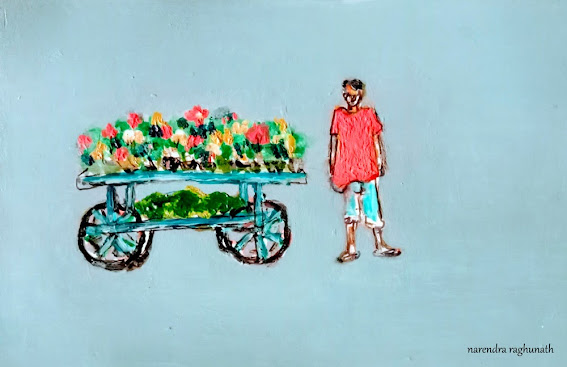When it comes to telling one's whereabouts, one can easily recognize a person from the north of India - whether they are from the city or from the village. If they are from cities or, in other words, are economically affluent, they would respond to your question by saying 'mein Raipur se hoon' kind. But if they are from the village, they would respond differently. They will say 'mein so-and-so village se hoon, jilla so-and-so.' While city dwellers will take pride in their city address, villagers seem to take pride in their Jilla or district. You will not find that identification as a strange behavior until you reach south India, where one will seldom identify oneself with a district other than their village. Perhaps that is the reason I first noticed Ram Yadav, a salesman of garden plants, on pushcarts. He did not add his district with his village name. Although I had never heard that village name before, my experience from Bengaluru told me that he had to be from the Aligarh district. Like all migrations have stories to tell, the stories of village migrations to this city also have their own particular story to tell. The security services are dominated by people from upper Assam or upper UP or Nepal. Plumbing jobs and the plywood industry are handled by people from Odisha, carpentry and tile laying by people from Bengal, electrical jobs by Andhrites, household jobs by Andhrites, Biharis, and then Kannadigas, jewelry work by Rajasthanis and Bengalis, and so on and so forth. In that unwritten order, farm/farmhouse work is often carried out by people from Azamgarh or Aligarh. I was correct in assuming that Ram Yadav was from the Aligarh district.
If you are from Yelahanka, chances are that you wouldn't have missed Ram Yadav by any chance, as he would be strolling around the fourth and fifth phases with his pushcart filled with garden pots and plants the whole day. Slightly dark with golden brownish hair, he always used to wear a red-brown round neck banian and knee-length folded blue jeans. I met him next to my campus in the fourth phase. I took four plants from his cart, asking the prices of each one separately, and returned the fourth one before asking him the final price. He was quoting exorbitant prices for those plants and was almost correct in his calculation, but when I returned one plant, he became confused and told me a completely wrong figure. That is when I realized the trick of his exorbitant price - he knew addition, but subtraction was difficult for him. So he would quote slightly higher prices, and in case he had to do subtraction and made mistakes, people would bring down the price and correct him anyway. I had a hearty laugh at his smart way of operation and joked with him about his subtraction. Although he joined me in my laughter, he stopped me from telling anyone about it. He told me, 'sir chaar thak pade hein, pet ka sawaal hein. Kisi ko bol na nahin' (I have studied only up to the 4th standard, it is a matter of hunger). I did not break the promise to him and continued my purchase from him. Although I did not buy many plants from him as most of the plants these boys bring are grown under the shade with heavy fertilizer application, he always brought good manure, and he became my regular supplier. Like all these kids from the village, he was a hero material, having the usual curious fashion sense. One day I gave him a duplicate Rayban-looking shade and a cap. He was thrilled to receive them, and the next day I saw him in the evening near Aroma bakery, wearing those accessories and walking down with his friends having animated conversations. Last year, after the first lockdown, when the markets were open, accidentally I met him on the street with a brown torn bag on his back. He was standing at the Aroma Bakery bus stand. He had a painful smile on his face when he told me that he is going back to his village. When I asked him when he is planning to come back, with a firm voice he replied - he will never come back, ever. After four years of living in this city, where he came looking for his life, all that he had was that torn brown bag and an empty pocket. I gave him the few rupees I had in my pocket that he refused to accept. Finally, after much persuasion, he accepted a couple of hundred rupees. A couple of days later, I saw another young boy of the same age, same style, same enthusiasm behind his cart. Ram Yadav told me once that every month, he got around three thousand five hundred rupees, a place to stay, and two-time meals in this city known as the Silicon Valley. In a city with eleven billionaires, where a square foot of land costs seven thousand to twenty-one thousand rupees, Ram Yadav and the faceless people like him from all over the country continue to come to seek the luxury of a few hundred rupees' worth of life. Like puppets, the strings that tie them will continue to make them feel like heroes in this spectacle called a city.
No comments:
Post a Comment